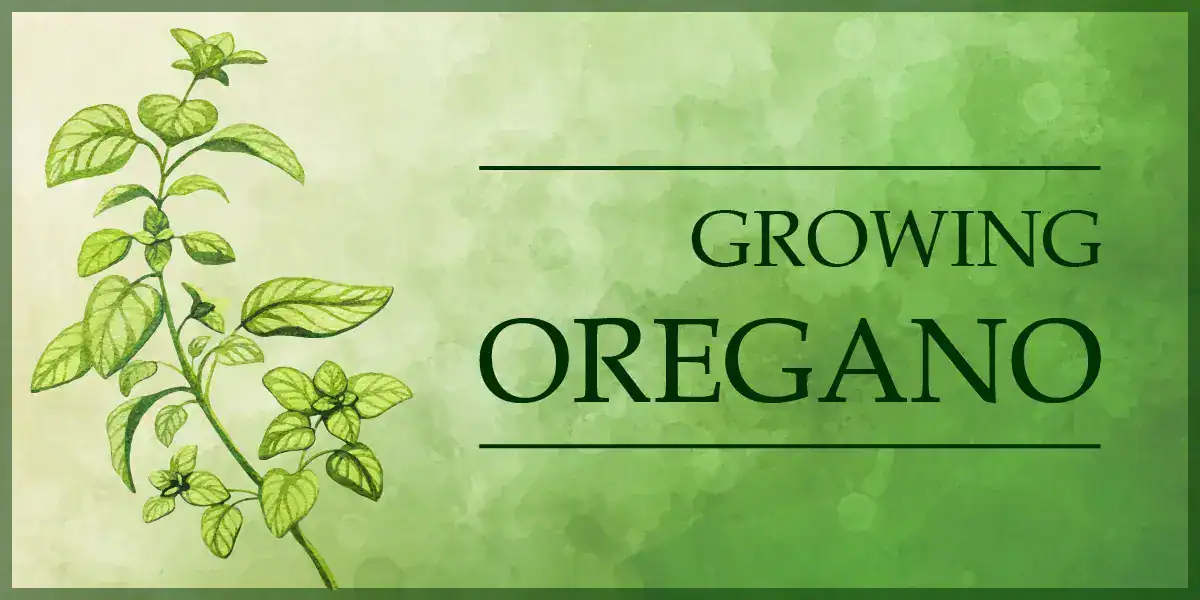“Oregano” comes from the Greek oros (mountain) and ganos (joy), translating to “joy of the mountain.” The ancient Greeks crowned newlyweds with the pungent plant.
The herb was uncommon in American cuisine before WWII, but GIs returning from Italy had developed a taste for pizza. What’s pizza without oregano? Niente. The growing popularity of Italian cuisine made oregano a must-have in well-stocked kitchens.

Thank you, Mama Italia, for America’s favorite dish.
Overview of Oregano
Oregano is a perennial mint herb, scientifically known as Origanum vulgare, native to the Mediterranean region.
The Origanum genus includes dozens of species. Greek and Italian oreganos are among the most aromatic and flavorful, while others like Syrian or Turkish oregano are more medicinal.
The plant produces small, aromatic, flavorful leaves and tiny purple or white flowers. Beyond its culinary value, oregano contains antioxidant and antimicrobial compounds like carvacrol and thymol.
The plant thrives in dry, poor soil and full sunlight, and is ideal for cultivation in Southern California.
Propagating Oregano
Division
This method works best for perennial varieties at least three years old. It involves separating a mature oregano plant into smaller sections and replanting them.
- Carefully dig up the entire plant with its roots intact.
- Gently shake off excess soil and untangle any intertwined roots.
- Using a sharp knife or gardening shears, divide the plant into smaller sections, ensuring each has its own set of roots.
- Replant the divided sections in well-draining soil and water thoroughly.
Cuttings
To take cuttings from an existing plant:
- Select a healthy stem from an established oregano plant.
- Cut a 3-5 inch stem section just below a leaf node (where leaves emerge).
- Remove any lower leaves on the cutting.
- Dip the end of the cutting into rooting hormone to encourage root growth.
- Place the cutting in a pot filled with damp soil. Bury the bottom of the stem and leave at least 2 inches of stem above the soil.
- Keep the cutting in a warm and bright location, but out of direct sunlight.
After a few weeks, you should see new growth on your cutting.
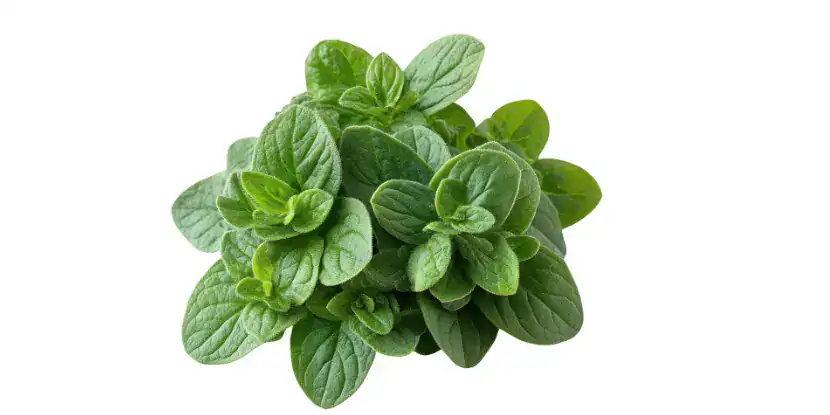
The aromatic, dark green foliage of an oregano plant.
Planting Oregano in Pots
- Choose a pot 6–12 inches in diameter with proper drainage holes. This size provides enough space for the plant’s roots to spread.
- Terracotta pots allow better airflow, while plastic retains moisture longer.
- Use a well-draining potting mix with sand or perlite to ensure proper aeration.
- Start with seeds, cuttings, or young seedlings. Seeds may take a bit longer.
- If planting seeds, press them gently into the soil and cover with a thin layer of soil. For cuttings or seedlings, dig a small hole, place the roots inside, and pat the soil around the base.
- Keep the soil moist but not soaked during the germination process.
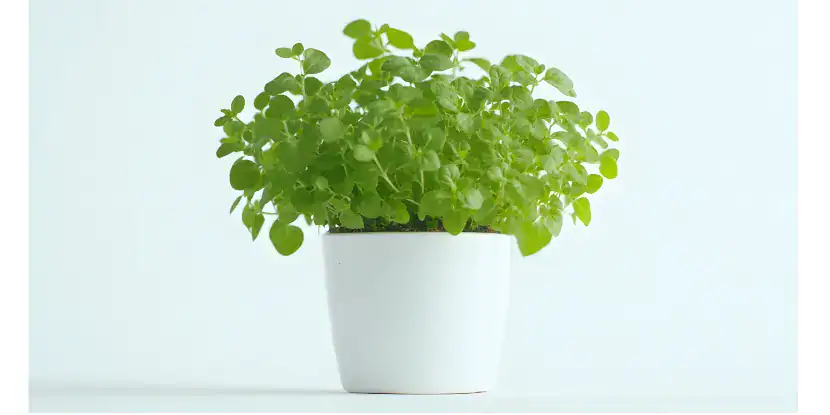
Oregano loves to be potted. Just give it plenty of sunlight!
Caring for Your Potted Oregano
Sunlight
- Place your pot in a spot with 6–8 hours of daily sunlight.
- Indoors, a sunny windowsill works perfectly.
Temperature
- Oregano loves warm temperatures. Keep your oregano in a room between 65-75°F (18-24°C).
- Move outdoor plants indoors if the temperature drops below 50°F (10°C).
Fertilizing
- Apply a balanced, organic fertilizer once a month during the growing season.
- Avoid over-fertilizing, which can dull the herb’s signature flavor. Oregano grows well even in less nutrient-dense soil.
Pruning
- Regular pruning encourages bushy growth. Trim back the stem tips often to maintain a healthy shape.
- If flowers appear, pinch them off. Flowering redirects energy away from the flavorful leaves.
Pest Control
- Oregano resists most pests, but you might see occasional aphids or spider mites.
- To address pest infestations, use natural solutions, like insecticidal soaps or neem oil.
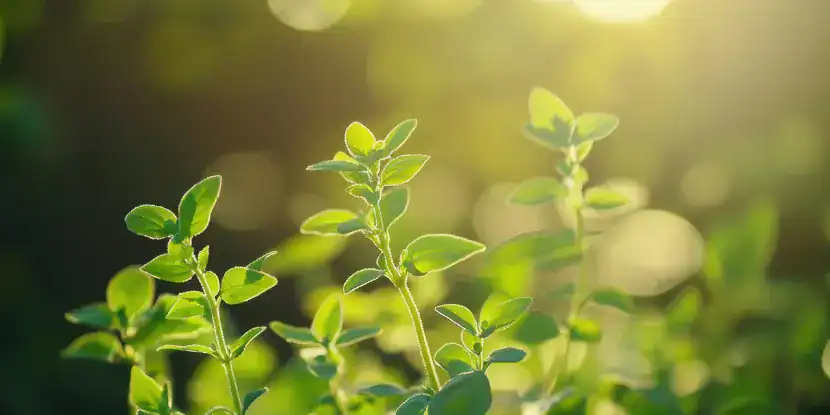
Oregano thrives in poor soil and full sunlight.
Tips for Growing Oregano Indoors vs. Outdoors
Growing Indoors
- If your home has inadequate bright natural light, supplement with grow lights.
- For optimal results, keep oregano in an area with temperatures around 70°F.
- Rotate the pot weekly to ensure even growth, as plants lean toward light sources.
Growing Outdoors
- Choose a sunny location, such as a patio, balcony, or garden bed.
- Bring your plant indoors or cover it with a frost cloth during colder months.
- Oregano pairs well with other container herbs like rosemary and thyme, and as an excellent companion plant for vegetables like tomatoes and beans.
- When planting in a garden bed, space plants at least 6 inches apart to allow air circulation.
Companion Planting
Companion planting is pairing plants for mutual advantage, like pest control, pollination, and soil enrichment.
Oregano is a companion plant par excellence. Its intense aroma can discourage pests like cabbage moths, cucumber beetles, and aphids.
It can also attract beneficial insects like bees and butterflies, essential for pollination.
Planting oregano alongside other herbs like basil and parsley can improve their flavor.
Other plants that benefit from growing near oregano include broccoli, cauliflower, and cucumbers.
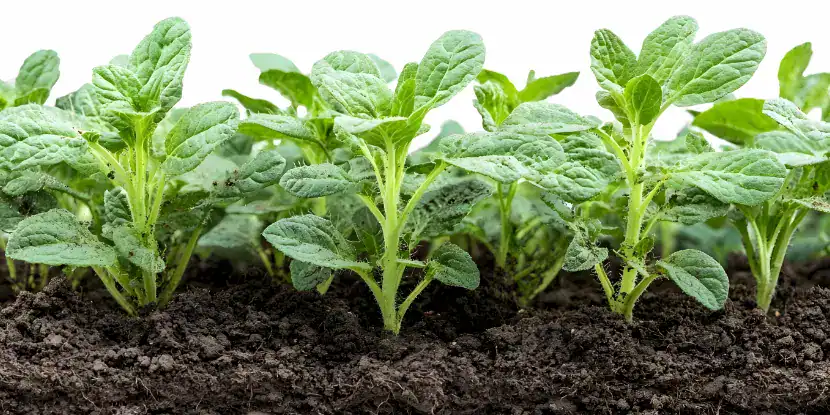
Young oregano plants in the garden.
Harvesting & Storing Oregano
Harvesting
- Harvest leaves once the plant is well-established, at least 6–8 weeks after sowing seeds. Pick your oregano early in the morning for maximum flavor.
- Use clean scissors to trim stems, leaving at least a third of the plant intact to encourage regrowth.
Storage
- If you’ve harvested more oregano than you need immediately, dry the leaves by hanging the stems upside-down in a cool, dark place.
- Once dried, strip the leaves from the stems and store them in an airtight container.
- Alternatively, you can freeze fresh leaves to preserve their flavor.
FAQs: Growing Oregano
Q: How long does it take oregano to grow?
Oregano takes about 6–8 weeks to mature when grown from seeds.
Q: Can you grow oregano year-round?
Indoors and in mild climates, oregano can thrive year-round with adequate light and warmth.
Q: How often should I water oregano?
Water your plant when the top 1–2 inches of soil feel dry.
Q: Does oregano require fertilization?
Fertilize monthly during the growing season with a balanced, organic fertilizer.
Q: Can I grow oregano from cuttings?
Oregano grows easily from stem cuttings. Place the cutting in water or directly into the soil.
Q: Should I use terracotta pots for oregano?
Terracotta pots are excellent for oregano, as they help prevent overwatering through better airflow and drainage.
Q: What pests affect oregano?
Aphids and spider mites are the most common pests, but natural remedies can quickly solve the problem.
Q: Can I grow oregano in partial shade?
Oregano prefers full sun but can tolerate partial shade with slightly reduced growth.

